Difference between Intercropping and Mixed cropping
Intercropping is a process of growing subsidiary crops between two widely spaced rows of main crop. The main object of this type of cropping is to utilize the space left between two rows of main crop and to produce more grain per unit area.
Mixed cropping refers to growing two or more crops together on the same piece of land simultaneously. The cereals are usually mixed with legumes, for example, wheat is mixed with peas, gram, or mustard.
Advantages of Mixed Cropping
- It minimizes the spread of pests and diseases, while also increasing productivity and providing food security for the farmer.
- Legumes in mixed cropping can improve soil fertility by adding nitrogen to the soil.
- This practice also helps to prevent soil erosion and increase crop yield.
- Closely spaced crops can also suppress weeds, and mixed cropping provides insurance against crop failure, reducing the risk for farmers.
- Less labor is required for farm operations, and equal care can be given to all crops.

Key Differences
Sr. No Intercropping Mixed Cropping 1 The main object is to utilize the space left between two rows of main crop especially during early growth period of main crop. The main object is to get at least one crop under any climatic hazard e.g., flood, drought, or frost conditions. 2 More emphasis is given to the main crop and the subsidiary crops are not grown at the cost of the main crop. Thus, there is no competition between main and subsidiary crops. Here all crops are given equal and there is no main or subsidiary crop. Almost all the crops compete with one another. 3 Subsidiary crops are of short duration, and they are harvested much earlier than the main crop. The crops are almost of the same duration. 4 Both the crops are sown in rows. The sowing time may be the same or the main crop is sown earlier than the subsidiary crops. The crops may be broadcasted or sown in rows but the sowing time for all the crops is the same.